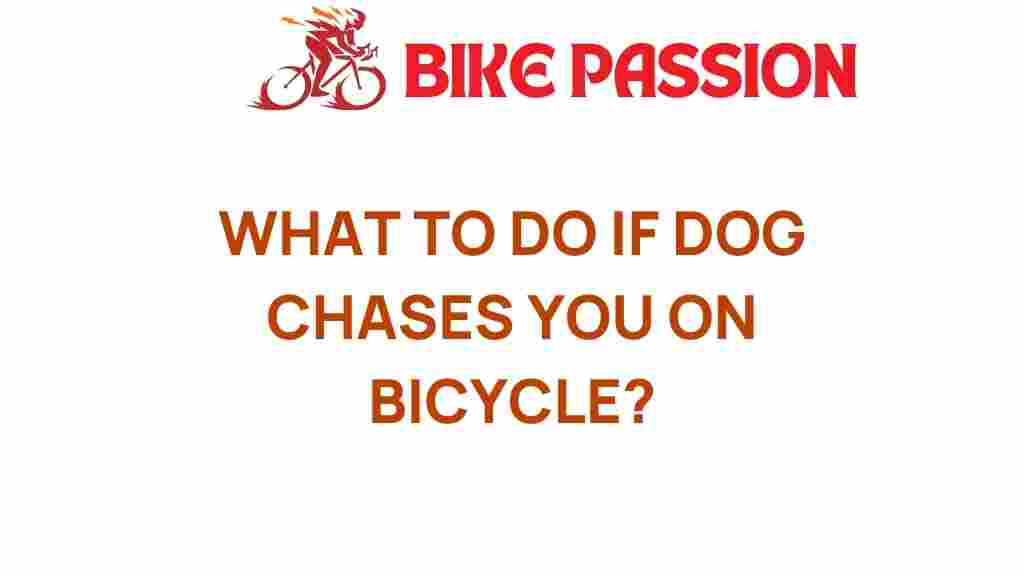How to Handle a Dog Chase While Riding Your Bicycle
Cycling is an exhilarating way to explore your neighborhood and stay fit, but it comes with its own set of challenges. Among these challenges is the potential for a dog chase, which can be a frightening experience for any cyclist. Understanding dog behavior and employing effective riding strategies can significantly enhance your bicycle safety during such encounters. In this article, we’ll explore practical cycling tips to handle dog chases, ensuring you can enjoy urban cycling without fear of unexpected pet encounters.
Understanding Dog Behavior
Before diving into strategies for handling a dog chase, it’s essential to understand how dogs typically behave. Dogs are territorial animals, and their instinct to chase can be triggered by various factors. Here are some common reasons why dogs may chase cyclists:
- Territorial Instinct: Dogs may feel threatened when a cyclist approaches their home or yard.
- Curiosity: Some dogs chase out of sheer curiosity or playfulness.
- Fear: A frightened dog may chase to assert dominance or protect itself.
By recognizing these behaviors, you can better prepare for encounters and react appropriately during a dog chase.
Step-by-Step Process for Handling a Dog Chase
When faced with a dog chase, your reaction can make all the difference. Here are step-by-step strategies to handle the situation effectively:
1. Stay Calm and Assess the Situation
As soon as you notice a dog approaching, take a deep breath and remain calm. Dogs can sense anxiety and fear, which may provoke them further. Assess the dog’s behavior:
- If the dog is barking aggressively, prepare for a potential chase.
- If the dog appears friendly, you may be able to continue cycling without issue.
2. Slow Down and Maintain Control
Reducing your speed can help you maintain control of your bike. Try to stay upright and avoid sudden movements that might startle the dog. Here’s what to do:
- Gradually slow down instead of suddenly stopping.
- Keep your hands firmly on the handlebars for better bike handling.
3. Use Verbal Commands
If the dog is approaching, using firm, confident verbal commands can sometimes help. Try saying:
- “No!” – This can discourage the dog.
- “Stay!” – This may prompt the dog to halt.
Speak in a calm but authoritative voice to convey control over the situation.
4. Avoid Eye Contact
Dogs can perceive direct eye contact as a challenge. Instead, look ahead and avoid staring at the dog, which may help de-escalate the situation. Keep your focus on the road ahead to maintain your balance and control.
5. Create Distance
If the dog begins to chase, try to create distance between yourself and the dog:
- Steer your bike towards a clear area, such as an open space or a sidewalk.
- Consider dismounting if the dog is particularly aggressive.
6. Use Your Bike as a Barrier
If the dog gets too close, use your bike as a barrier between yourself and the dog. This can provide you with protection and help you maintain your balance:
- Keep the bike between yourself and the dog.
- Stand tall on the pedals to avoid being knocked over.
7. Know When to Disengage
If the situation escalates and the dog appears ready to bite, it’s essential to prioritize your safety. Here’s how:
- Get off your bike and move to a safe location, if possible.
- Stay still and avoid sudden movements.
Troubleshooting Tips for Common Scenarios
In some cases, you may encounter unique situations during a dog chase. Here are some troubleshooting tips for common scenarios:
1. Multiple Dogs
If you spot a pack of dogs, try to remain calm and avoid sudden movements. Steer your bike in a different direction and look for an escape route.
2. Aggressive Breeds
Some dog breeds are known for their aggressive tendencies. If you encounter such a breed, consider the following:
- Maintain a firm grip on your handlebars.
- Try to keep your bike between you and the dog.
3. Dogs on Leashes
If you see a dog on a leash, be cautious. The owner may not have control over the dog. Slow down and give the dog plenty of space. If the dog lunges, be prepared to execute your handling strategies.
Additional Cycling Tips for Urban Environments
To minimize the risk of dog chases and enhance your overall cycling safety in urban settings, consider the following tips:
- Stay Visible: Wear bright clothing and use lights on your bike to increase visibility.
- Stick to Designated Paths: Use bike lanes whenever possible to reduce interactions with pets and pedestrians.
- Plan Your Route: Avoid areas known for loose dogs or high pet activity.
By implementing these strategies, you can significantly reduce the likelihood of encountering dog chases and increase your overall safety while cycling.
Conclusion
Handling a dog chase while riding your bicycle can be a daunting experience, but with the right knowledge and strategies, you can navigate these encounters safely. Understanding dog behavior, employing effective bike handling techniques, and being prepared for various scenarios are crucial steps for enhancing your bicycle safety.
Remember to stay calm, maintain control, and use your bike as a barrier when necessary. By following these cycling tips, you can enjoy urban cycling and pet encounters without fear. For more resources on cycling safety, visit this helpful site for additional information.
For further reading on dog behavior and safety tips, check out this article. Happy cycling!
This article is in the category Training and created by BikePassion Team
